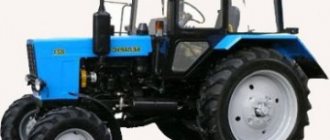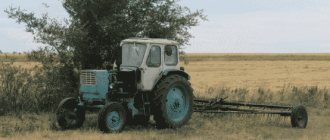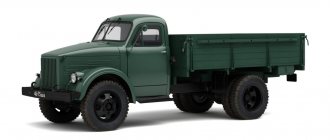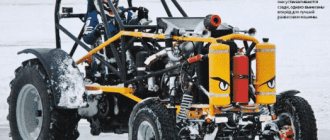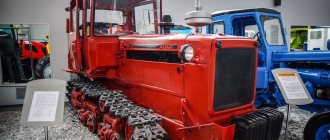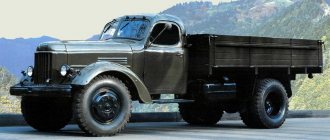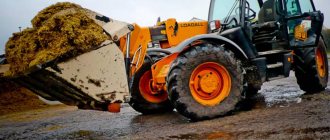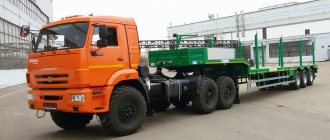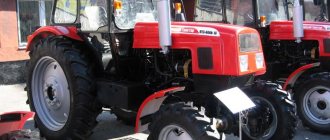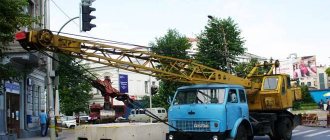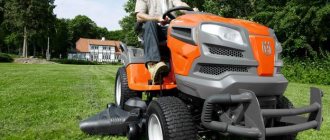| DT-14 | |
| Issued, gg. | 1955-1959 |
| Manufacturer | Kharkov Tractor Plant named after Sergo Ordzhonikidze |
| Purpose | general purpose |
| Propulsion type | wheeled |
| Location | |
| Engine: | front |
| Main Dimensions | |
| Engine | |
| Engine make | |
| Power, hp (kW) | 14 |
| Transmission | |
| Suspension and handling | |
| Equipment | |
| The lineup | |
DT-14
is a brand of light wheeled tractor produced by the Kharkov Tractor Plant from 1955 to 1959.
The tractor is designed for work in vegetable growing on light soils with trailed and mounted equipment, for transporting goods and various auxiliary work. DT-14 is the result of modernization of the HTZ-7 tractor. Unlike its predecessor, it is equipped with a single-cylinder diesel engine D-14
with a power of 14 hp.
Gasoline was used to start the engine. In 1957, a modification appeared DT-14A
D-14A
engine running on gasoline using an electric starter.
Since the end of 1957, modifications DT-14B
, in which an electric starter started the
D-14B
directly on diesel fuel. At the time of launch, a reduced compression ratio (decompression) was used.
Purpose
The DT tractor was produced on a wheeled and tracked chassis. Light wheeled vehicles are designed to perform work in vegetable growing, plowing soft soil, and transporting goods on small trailers. Powerful crawler tractors are used as tractors, agricultural or construction machines. Sprinklers, drilling stations and other equipment can be installed on the tractor base.
Upon request, DT tracked vehicles were produced with a chassis adapted for movement on muddy ground or steep slopes. The track belts of the machines are equipped with links with increased width. The drive wheels have a larger diameter, which made it possible to increase the support surface of the caterpillar and reduce the specific pressure on the ground. The links are equipped with lugs that increase maneuverability on soft ground.
DT-12
The DT-12 Cameo minitractor has nothing to do with machines developed in the USSR. A Chinese small-sized tractor with a 12 hp diesel engine is sold under this name. at 2400 rpm. The engine is equipped with one cylinder with a displacement of 632 cm³. The diesel engine has forced lubrication; oil is supplied from the crankcase, which holds 1.5 liters of liquid. An electric starter or crank is used for starting.
The transmission consists of a 1-disc clutch and a manual 3-speed gearbox. The clutch is connected to a belt transmission. The box is equipped with an additional lower row, expanding the possibilities of using the tractor. When driving on the highway, the car reaches a speed of 23 km/h. To stop, drum brakes are used on the rear axle.
The tractor is equipped with a hydraulic system designed to control attachments. At the rear of the machine there is a shaft that serves to drive agricultural equipment. The shaft is covered with a safety metal screen.
Above the rear wheels there is an operator's workplace equipped with a soft seat, adjustable by distance from the pedal assembly. The design does not provide for a canopy or roll bar. The mechanical steering is equipped with a worm gearbox. The weight of the DT-12 tractor in running order is 410 kg.
User manual
The instructions contain only a few sections that require special attention from the operator of the tracked vehicle:
- Design of the DT-175 tractor;
- Specifications;
- Safety requirements;
- Running in the power plant;
- Maintenance;
- Problems, their causes and recommendations for elimination.
Let's briefly look at some sections
First launch, run-in
This procedure will extend the life of the engine and other parts of the agricultural machine. The procedure lasts about 8-10 hours. During this time, the moving parts of the power plant, gears, and other structural elements are ground in and adjusted.
At the end of the running-in period, the oil in the engine crankcase and transmission is completely replaced.
Maintenance
The DT-175 tractor machine is easy to maintain and repairable. To ensure a long service life without breakdowns, it is enough to follow the following rules:
- Completely change the engine oil every 100 operating hours; it is recommended to use engine oils: M-10G2k and M-10DM.
- Replace the transmission lubricant every 1000 operating hours; transmission oil of the Tap-15v brand is recommended.
- When preserving the tractor, do not forget to drain the working fluids.
- Use only high quality working fluids.
Basic malfunctions and ways to eliminate them
The engine does not start, stalls:
- the fuel has run out (gasoline in the launcher or diesel fuel in the diesel engine);
- the lubricant has run out;
- filter elements (for air or fuel) are clogged;
- the starter ignition system has failed (the spark plug, magneto has burned out, the high-voltage cable has fallen off, etc.);
- the starter fuel supply system is clogged or out of order (carburetor, hoses, filter, etc.);
- The diesel fuel injection pump is clogged or faulty.
The starter does not start the engine:
- the wire does not make contact or is broken;
- the battery is low;
- the magnetic switch does not contact;
- a short circuit has occurred.
Hydraulics does not respond:
- the hydraulic pump is turned off;
- oil level is below normal;
- The safety valve does not work well.
The brake system has failed:
- brake pads are worn out;
- brake discs are worn out;
- the brake pedal needs to be adjusted.
DT-14
A lightweight wheeled tractor designed for light agricultural work. Created on the basis of the HTZ-7 petrol car. The car used a 1-cylinder diesel engine model D-14, which developed a power of 14 hp. Gasoline was used for starting. The head had a decompression mechanism to avoid detonation combustion. The decompressor provided a reduced compression ratio, and after starting and warming up, a switch was made to diesel fuel. The decompressor was switched off.
In 1957, a modification DT-14A was produced, equipped with an electric starter and electrical equipment designed for a voltage of 12V. Since the fall of 1957, the DT-14B version went into production, which made it possible to start the engine on diesel fuel, without temporarily switching to gasoline. The tractor was equipped with a separate hydraulic system.
The engine and transmission of the tractor were used on the self-propelled chassis DSS, which was produced in Kharkov until 1961. The chassis was used for mechanization of agricultural work, and also as a vehicle.
Based on the Model 14, the modernized DT-20 was created, which was produced until 1969. The operation of the tractors has been discontinued; preserved and restored machines can be seen in the Museum of Domestic Tractors, located in Cheboksary.
First diesel
The diesel engine, invented in 1890 by R. Diesel and adapted for use in motor vehicles in the 1920s by R. Bosch, has undeniable advantages over the carburetor engine: it consumes about 30% less fuel, which is less dangerous in terms of fire, it does not have an ignition system , which reduces the number of possible malfunctions during operation. But there is also a downside: in a diesel engine, the load on all mechanisms and parts is much greater, which leads to an increase in its weight and size, and high precision is required in the manufacture of fuel equipment.
In the early 1930s, taking into account all the pros and cons of diesel, the Soviet government decided that the use of tractors with such an engine would be economically profitable, and decided to urgently establish industrial production of diesel engines and new tractors.
In February 1935, designers at ChTZ, headed by V. Lomonosov, and at the Scientific Automotive and Tractor Institute (NATI) under the leadership of A. Lebedev began designing the engine. To speed up the work, they wanted to involve the American company Caterpillar in cooperation, because it was its tractor that at one time became the prototype for the C-60. However, the company's president refused to work together, fearing competition, and Soviet designers continued designing on their own.
Based on two prototypes (ChTZ and NATI), the M-75 diesel engine was created. On its basis, under the leadership of engineer E. Gurevich, the M-17 diesel engine was assembled by July 15. As required, very minor changes were made to the tractor itself: the gear ratio in the final pair of gearboxes was increased, one link was added to the track, the location of the fuel tank was changed, and the radiator was slightly widened. On August 14, a prototype tractor with a new engine made its first 15-kilometer run around the plant site.
Important Design and technical characteristics of the large BelAZ-75131 dump truck
It took several more months to eliminate the shortcomings discovered during testing; in March 1937, the last S-60 tractors rolled off the assembly line, and on June 20, the plant produced the first diesel tractor S-65. But a little earlier, in May, a prototype of the new “Stalinist” received the highest award, the Grand Prix, at the international exhibition in Paris “The Art and Technology of Modern Life”. Already in February 1938, 60 S-65 tractors were exported.
DT-24
A light wheeled tractor used in agriculture. The machine was produced by the Vladimir Tractor Plant in the 50s. A modification was developed on the basis of the tractor, intended for work on cotton plantations, which was distinguished by closer front wheels. The cotton version was produced in Uzbekistan until 1970.
The tractors used a 2-cylinder 4-stroke D-24 engine with compression ignition. The engine had a dual power system, which made it possible to supply gasoline or diesel fuel to the cylinders. The power unit was started on gasoline by rotating a special handle. The cylinder head is equipped with a decompressor that temporarily reduces the compression ratio. After start-up and warm-up, the diesel fuel supply was turned on, and the decompressor mechanism was turned off.
Torque from the engine was supplied to a 7-speed gearbox through a 1-plate dry clutch. The drive wheels are rear-mounted, the drive has a differential without the possibility of locking. To stop, brake mechanisms acting on the transmission were used. The front wheels are swivel, the steering mechanism is mechanical, there is no power steering.
The operator was located in an open area located between the rear wheels. The tractor was equipped with hydraulics, which provided separate control of the units. The total weight of the vehicle was 2590 kg, the tractive effort was 0.6 tons.
Kirovets K744
The model is produced at the St. Petersburg Tractor Plant. The basic modification is made on wheels with low-pressure tires. Additionally, it is possible to replace the wheels with specialized tracked modules. The tracks of the K744 tractor are made of reinforced rubber, thanks to which the machine can move on asphalt surfaces without damaging it.
Kirovets K744 has 4 modifications, the main difference of which is the power of the power plant. The manufacturer installs an automated gearbox with leverless control on the tractor. Switching is carried out by the joystick and the buttons located on it. The gearbox has 16 forward gears and 8 reverse gears.
The tractor cabin is distinguished by a high degree of comfort and functionality. An on-board computer is installed in the K 744 cockpit. It informs the operator about the operation of all systems and mechanisms. The controls are located in close proximity to the operator's seat. This arrangement allows the tractor driver to easily operate a multi-ton machine. T744 has proven itself well when performing any type of agricultural work in various climatic conditions.
From the above it follows that since the times of the Soviet Union, the domestic tractor industry has been developing. Regardless of the fact that tracked vehicles are less in demand than wheeled vehicles, they are constantly being modernized, and in many technical indicators they are not inferior to foreign analogues of the corresponding class.
DT-50
The designation DT-50 is erroneously assigned to wheeled tractors MTZ-50, produced by the Minsk Plant. The machines were produced for more than 20 years and sold 1.26 million units. The tractor is built according to the classic design: a semi-frame chassis with supporting housings for the gearbox and rear axle.
A 4-cylinder 55-horsepower diesel engine was used as a power unit. Export modifications with a 65-horsepower engine were produced. The tractors used a 9-speed mechanical transmission, which allowed them to reach speeds of up to 25 km/h. Many design solutions were used by the MTZ plant in the development of the next generation of machines - the MTZ-80/82 tractors.
A tractor manufactured by Landini was supplied to Russia under the designation DT-50 Mistral. The vehicle is equipped with a 48 horsepower 4TNE88 Yanmar diesel engine and a 12-speed manual transmission with drive on both axles. The power unit complies with Euro-3 emission standards. The cooling system is liquid, equipped with a radiator with increased heat transfer. To work with attachments, hydraulics and a 2-speed power take-off shaft are installed in the stern location.
The operator is located in a closed cabin with a large glass area. The workplace is equipped with a seat with a shock absorber, which is adjustable in several directions. Hydrostatic power steering. Upon request, the vehicles were equipped with an air conditioning unit.
DT-55
The DT-55 crawler tractor belongs to the 3-ton traction category and is equipped with a chassis adapted for work in wetlands. The vehicle was based on the units of the tracked DT-54. Since 1958, the modernized DT-55A was produced at the production facilities of the Volgograd Tractor Plant.
There were four types of tractor:
- 55A-C1, equipped with separate hydraulics and a set of remote power hydraulic cylinders;
- 55A-C2, equipped with a separate hydraulic system without remote and main cylinders, no linkage;
- 55A-C3, does not have hydraulics and a hinge on the stern;
- 55A-C4, identical to the C1 model, with the exception of the removed remote units.
All versions are equipped with a D-54A naturally aspirated diesel engine developing 54 hp. A special feature of the power unit is the vortex chambers located in the piston heads. The engine is equipped with a gas distribution mechanism with a lower camshaft. The valves are driven by rods and rocker arms. The power unit is started by a PD-10M starting gasoline engine.
The transmission consists of a 1-disc dry clutch and a 5-speed gearbox. An additional reduction gearbox can be installed in front of the box housing, increasing the number of gears by 2 times. The gearbox is used when working with transplanting agricultural machines.
Owner reviews
- I purchased a TZ-4K-14 minitractor in used condition, however, after 9 months of hard work on the site, not a single serious failure or breakdown occurred. Of course, the lack of a roof was often annoying, but the production rate was the smallest; tractor drivers working on Belarusian models and YuMZ-6 were even sometimes envious.
- At the moment, this mini-tractor is being repaired due to transmission faults. We purchased it back in 1998, and the machine worked conscientiously for almost two decades. During the entire period of operation, the crankshaft was restored only once and the cylinder was bored during a major overhaul. The tires on the front axle were also changed and the repairs were supplemented by replacing the oil seals. An extremely reliable technique, it’s a pity that it was discontinued. Somewhere abroad these cars seem to be produced under a different name, but this model is not imported to us.
DT-80
This is the unofficial name given to the DT-75B/75K/75V vehicles, equipped with an engine with increased hp to 80. power. Not a single plant in the USSR produced tractors with the designation DT-80.
Another Landini tractor supplied to Russia has the DT-80 Rex marking. The vehicles were equipped with an 82-horsepower 1103C33 Perkins diesel engine equipped with a turbocharger. The tractor is equipped with hydraulics designed to control front and rear attachments. The gearbox is mechanical, equipped with several shafts to drive additional equipment.
The operator's cabin is closed and equipped with heating and ventilation systems. The standard delivery includes an air conditioner equipped with a filter. The side doors of the cabin are made entirely of glass; there is a reinforcing frame around the perimeter.
Attachments
The list of additional attachments that the TZ-4K-14 minitractor can use includes such units as:
- Mower.
- Bulldozer blade.
- Sweeping machine.
- Mounted cutter.
- Ripper.
- Reversible plow.
- Cultivator.
As for trailed equipment, the model can use a dump trailer.
DT-90
An agricultural and construction crawler tractor, built on the basis of model 75. The full name of the machine is DT-90P. The tractor is equipped with an in-line 4-cylinder diesel engine D-440. The engine is equipped with a modified cylinder head adapted to install a turbocharger. The cooling system is liquid, with forced circulation and a thermostat. The engine develops a power of 95 hp, while providing a torque reserve of at least 35%.
The tractor uses a mechanical 7-speed gearbox equipped with a stern output of the power take-off shaft. As standard, the shaft has a rotation speed of 540 rpm. There are machines equipped with a shaft that provides a rotation speed of 1000 rpm. The plant produced such configurations on a separate order. The chassis consists of 4 road wheels, interlocked in pairs on bogies. The drive wheel is located at the rear, and a drive roller is installed at the front, which is used to tension the track.
The DT bulldozer is equipped with a blade, which is controlled by a hydraulic cylinder located in front of the radiator. The push bars are installed on an axle mounted on the tractor frame between the undercarriage bogies. The operation is controlled by the operator from the cabin, in which a hydraulic distributor is installed.
The DT-90P vehicles use a frame-type metal cabin. To install the cab on the chassis, rubber cushions are used to reduce vibration load. The equipment includes an air heater connected to the cooling system. In summer, the air in the cabin is cooled using an evaporative device installed in the ventilation system. The side walls are lined with soft material that absorbs sound and further reduces vibration.
Cabin
The new model has a modernized ergonomic cabin with a convenient layout of control levers and instrument panel. It is placed on seven rubber shock absorbers that reduce vibration. The driver's seat is sprung above the right track. The furrow is clearly visible from it. The cabin has excellent sound insulation. Special coatings are applied to its roof and walls to protect against summer heat and winter cold. The glass is darkened with a tin-antimony or titanium coating that does not transmit sunlight.
The working equipment is driven by a power take-off shaft mounted on the rear surface of the transmission housing. A two-speed, dependent PTO is connected to the gearbox input shaft. It provides the output shank with two speeds: 9 rpm (540 rpm) and 16.7 rpm (1000 rpm).
Other models
The designation DT-15 is for a Chinese small-sized wheeled tractor equipped with a single-cylinder diesel engine with a power of 15 hp. The engine is started by an electric starter or manually. Manual starting is accomplished by a crank handle, which is used to rotate the crankshaft through a ratchet. The machine's transmission includes a 3-speed gearbox with an additional range. The drive wheels are located at the rear, the differential is not equipped with a lock.
To carry out work on slopes, a special tracked vehicle DT-57 was produced. The design of the tractor made it possible to work on slopes with swampy or rocky soil with a steepness of up to 25°. The machine could be used in high-mountainous areas located at an altitude of 2000 m. The D-54A diesel engine was equipped with a modernized oil intake, which prevented the engine from starving of oil when the tractor moved along slopes. The cooling system became closed, which avoided the formation of scale.
The machine uses guide wheels of increased diameter, equipped with an additional longitudinal spring. The operator's cabin is equipped with 2 workstations installed symmetrically relative to the controls. When operating the tractor, a reverse method was used, which made it possible to avoid turning the machine at the end points of the trajectory.
Trailed and mounted equipment of the same type was installed on the front and rear of the machine. The duplicated mounted system is equipped with a single hydraulic network. The hydraulics include a safety element that prevents the simultaneous use of the front and rear linkages.
The designation DT-35 means a domestic row-crop tractor, produced at the Lipetsk Tractor Plant until 1960. The machine has the official name KD-35; modernized tractors produced since 1950 were called KDP-35. The difference between the modified vehicle was the modified chassis, which received a widened track and narrow caterpillar tracks.
The vehicles used 4-cylinder diesel engines of the D-35 and D-40 models, developing 35 and 45 hp. respectively. The transmission included a 5-speed gearbox equipped with a mechanical shift drive. The chassis was equipped with tracks with a link width of 280 and 200 mm. To work with attachments, a hydraulic system with lines connected to the rear of the machine is used.
Equipment design
To get to know this rare tractor better, you need to look at each working unit of the machine in more detail.
Tractor DT-20
Chassis
The DT-20 model tractor was equipped with driven rear wheels and steered front wheels. A semi-rigid suspension was used, supplemented by a spring. The design of the chassis allows you to change the track width of the rear and front wheels.
To change the track of the rear axle, it was necessary to rearrange the disks and wheel rim. With steered wheels everything was much simpler; the designers installed a telescopic front axle.
Engine
The DT-20 tractor was equipped with a four-stroke single-cylinder diesel engine D-20. One of the features of this unit is the ignition of fuel due to the compression ratio.
The diesel power in the basic configuration was 18 horsepower. This indicator is relevant at a crankshaft rotation speed of 1,600 rpm. On some modifications, the torque was increased to 1,800 rpm.
This contributed to an increase in power to 20 horsepower. The basis for the power plant was a diesel engine from the previous model of Kharkov manufacturers - DT-14B. Among the innovations it is worth noting:
- new crankcase and cylinder head;
- the breather valve began to be made of rubber.
Important TOP 4 Mustang mini loaders and their device features
These features increased engine performance and made it more economical in terms of fuel consumption.
Tractor DT-20
Transmission diagram
The gearbox is mechanical, equipped with transverse shafts and has four gears. All gears except one have reverse. A transmission without reverse operates at a reduced crankshaft speed. This gives the tractor the necessary force to operate the attachment.
The rotary mechanisms were mounted in the same housing with the gearbox. The turning mechanism is made in the form of a two-satellite bevel differential. A single-plate clutch is installed between the engine and the transmission system. It is combined with the main gear using a rigid detachable connection.
Specifications:
| Weight | 1,560 kg |
| Length Width Height | 3 038/1 310/1 438 mm |
| Track, adjustable | 1 100-1 400 mm |
| Ground pressure | 0.046 kilograms per square centimeter |
| Installed power plant | D-20 |
| Fuel consumption | 200 g/l hour |
| Fuel tank volume | 45 l |
| Maximum driving speed | 17 km/h |
Working with attachments
The DT-20 tractor is equipped with a hydraulic system, which is responsible for the operation of mounted and trailed equipment. The installed hydraulics were of a separate-aggregate type. The hydraulic fluid was supplied using an unregulated gear pumping station.
The spool was responsible for distributing the liquid. The spool valve could operate in four modes: neutral, lowering, lifting and floating position. The distributor was controlled from the driver's cab. Thanks to this, the machine could work with the following units and mechanisms:
- equipment for picking and transporting grapevines – LNV 1.5 and PAV 000;
- devices for spraying and pollinating plants - ONK-B and OSHU-50;
- platform PVF-0.5 and drags AVN-0.5.
It is worth clarifying that this equipment was mounted on the base model DT-20. Subsequent modifications could be equipped with other units.
Tractor DT-20
Advantages and disadvantages
The common DT bulldozer is used during construction and road work. The popularity of the machine is explained by the reliability and maintainability of the design. No special equipment or tools are required to perform engine or transmission repairs.
The disadvantages of diesel engines include a weak hydraulic system and low comfort in the operator's cabin.
The cars do not have air conditioning and the heating system is not very efficient. The exception is the DT tractor produced by Landini Mistral, which is related to Soviet technology only by the abbreviation DT.
